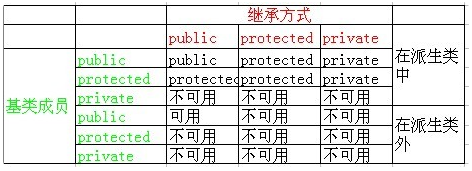直接上图:

以及:

实践如下:
#include <iostream> using namespace std; class Father{ private: int father1; int getFather1Private(){ return this->father1; } protected: int father2; int getFather2Protected(){ return this->father2; } public: int father3; Father(){ this->father1 = 11; this->father2 = 10; this->father3 = 22; cout<< "无参构造器"<<endl; } // 基类构造器要加virtual的原因: // 这是因为当用基类引用派生类的时候,如果此时对基类进行delete操作,对于没有虚函数析构函数,那么只会调用基类的析构函数,而对派生类的析构函数不会进行析构 virtual ~Father(){ cout<< "Father析构函数"<<endl; } Father(int aa){ this->father1 = aa; this->father2 = 10; this->father3 = 22; cout<< "有参构造器"<<endl; } int getFather1(){ return father1; } int getFather2(){ return father2; } int getFather3(){ return this->father3; } }; class Son : public Father{ private: int son1; public: Son(){ this->son1 = 11; } ~Son(){ cout<< "Son析构函数"<<endl; } // 通过这样的方式调用父类构造器 Son(int fatherV, int sonV):Father(fatherV){ Father::father3 = fatherV; this->son1 = sonV; } int method(){ int value = son1 * Father::father3; return value; } int getSon1(){ return son1; } }; int main(){ cout << "类继承实践:" << endl; // 调用无参构造器 Son son1; // 有参构造器 Son son(121,222); // 在类外部仅有父类的public可以访问 // error: cout << "son.getFather1Private():" << son.getFather1Private() << endl; // error: cout << "son.getFather2Protected():" << son.getFather2Protected() << endl; cout << "son.getFather1():" << son.getFather1() << endl; cout << "son.getFather2():" << son.getFather2() << endl; cout << "son.father3:" << son.father3 << endl; // error: cout << "son.father2:" << son.father2 << endl; cout << "son.getSon1():" << son.getSon1()<< endl; //cout << "son.father3:" << son.son1 << endl; cout << "son.method():" << son.method() << endl; // https://blog.csdn.net/u014453898/article/details/60402586 // 这是因为当用基类引用派生类的时候,如果此时对基类进行delete操作,对于没有虚函数析构函数,那么只会调用基类的析构函数,而对派生类的析构函数不会进行析构 Father *ptr = new Son(); cout << "泛型:" << ptr->father3 << endl; delete ptr; cout << "类继承 实践 end." << endl; return 0; }